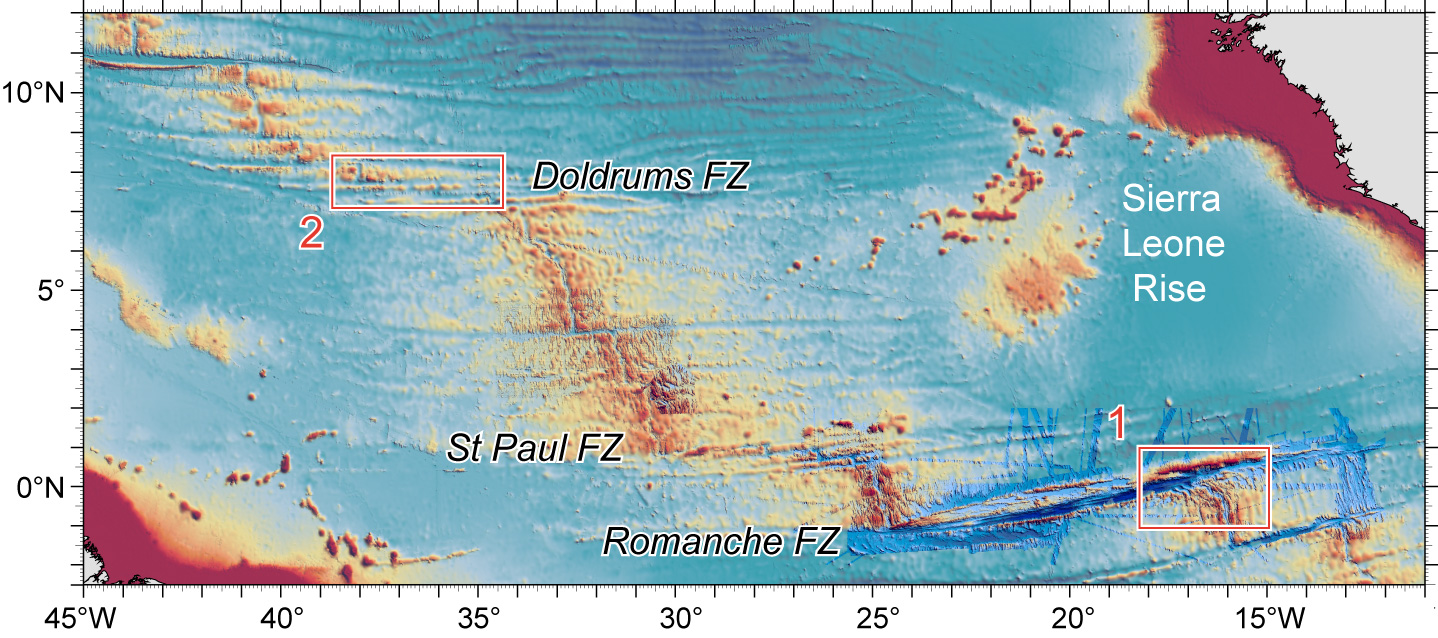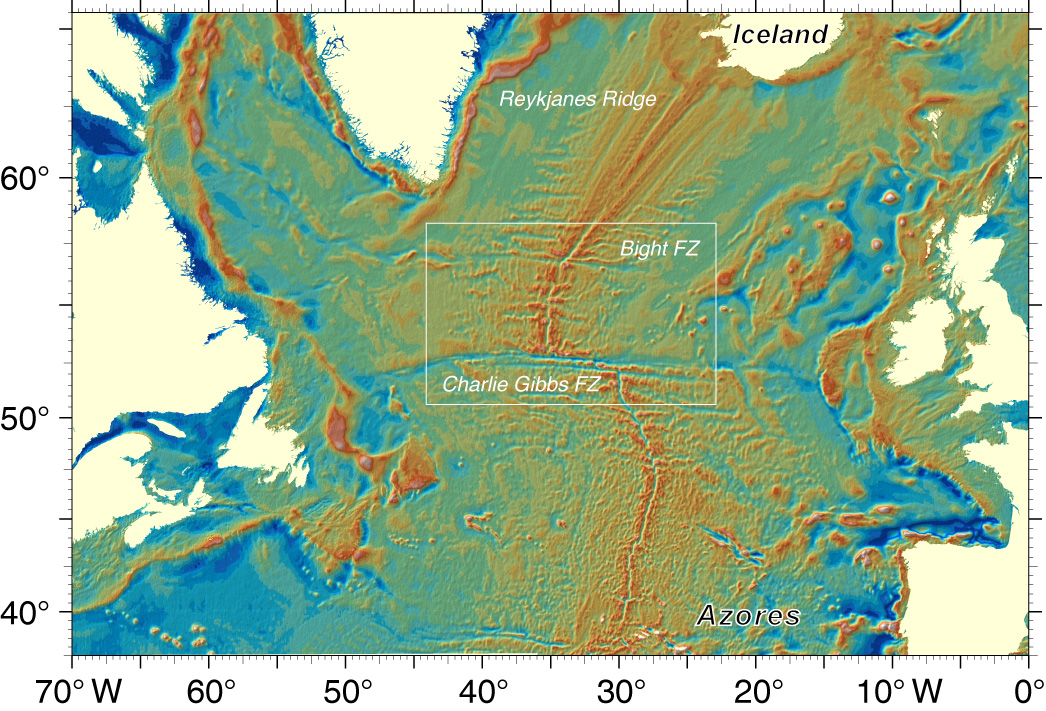The introduction by Wilson of the concept of transform fault was one of the key steps in the development of the theory of Plate Tectonics. Transform faults offset the axis of mid ocean ridges, and are the locus of strike slip motion at the boundary of two plates that slide past each other. The main objective of this project is to study tectonic, magmatic, hydrothermal and geodynamic processes acting at long-offset slow-slip oceanic transforms called here megatransforms. We suggest that oceanic megatransforms constitute a new type of plate boundary.
Our previous work on these themes has been at the forefront of research, and we have produced significant contributions to the geology of these regions. Oceanic transform boundaries generally lie on small circles defined by Eulerian poles of rotation, and are manifested by narrow (a few km) strike slip fault zones joining the two offset ridge segments. This is in contrast with continental transform systems, such as the St. Andreas or the N. Anatolian faults, that display broad (>100 km) and complex areas of deformation. The idea of simple, narrow oceanic transform faults has found exceptions in few long-offset slow-slip transforms such as Romanche that offsets the equatorial Mid Atlantic Ridge by over 900 km and Andrew Bain that offsets the South West Indian Ridge by about 750 km. Both transforms, display a lens-shaped, >120 km-wide zone of deformation between the two ridge axes, with multiple strike-slip faults as well as oblique structures; moreover, the basaltic crust is nearly absent within and close to the ridge-transform intersections (RTI

Figure 1. The equatorial portion of the Mid-Atlantic Ridge (MAR) is offset by over 2000 km through a set of major transform fault systems: Romanche, St Paul, Doldrums and Vema. Numbered red boxes indicate the proposed working areas: 1, the Romanche eastern ridge-transform intersection; 2, the Doldrums transform system.
.
In this Project we propose to investigate the mechanisms leading to the formation of megatransforms and their evolution in space and time, and to examine the magmatism generated at their RTIs. Megatransform RTI's are ideal sites to investigate mantle and deep lithospheric accretionary processes because the strong decrease of magmatic crust production due to an enhanced cold edge effect, proportional to slip rate and offset length. The resulting mantle exhumation and reduction in the extent of melting allows to detect chemical variability of the mantle source, melt transport and extraction beneath mid ocean ridges. Our proposal addresses five major issues: 1) detailed morphological, structural and geophysical surveys of the eastern Romanche RTI and of the Doldrums transform to unravel their tectonic evolution through time (Fig. 1). Two expeditions are planned: the former with R/V Pourquoi Pas?, scheduled in 2019 and funded by the Flotte Oceanographique Francaise, includes multibeam, AUV microbathymetry and direct sampling with submarine Nautile of the Romanche RTI. The latter with R/V Strakhov in 2020 in cooperation with the Institute of Geology of Moscow includes multibeam, gravity, magnetics and seismic reflection, together with along-axis systematic sampling of ridge segments next to Doldrums RTIs; 2) a petrological-geochemical study of the crustal and mantle rocks is proposed in order to determine how megatransform systems affect mantle upwelling and melting along the Mid Atlantic Ridge. The analytical program includes mineralogy, major and trace element composition as well as radiogenic (Nd, Sr, Hf and Pb) and stable (Fe, Cu and Cr) isotopic chemistry. The aim is to constrain the characteristics of the mantle reservoirs in terms of lithology, scale, age and origin of mantle heterogeneities. Thermodynamic and geochemical modelling of magma genesis will provide a quantitative estimate of melting energies versus source compositions; 3) a petrological-microstructural characterization of exhumed mantle rocks, gabbroic intrusions and dykes is proposed to define deformation patterns, to assess the extent of melt/fluid rock interactions and the evolution of the rheological properties, and to determine their role in the mechanisms of deformation; 4) fieldwork will be carried out in order to detect basalt- and ultramafic-hosted hydrothermal fields; 5) geodynamic theoretical modelling will be developed incorporating lithospheric rheology and regional stress regime in order to assess megatransform evolution through time and the interplay with mantle processes.

Figure 2. The Mid-Atlantic Ridge (MAR) between Azores and Island. The Charlie Gibbs transform system consists of two long-lived transform faults separated by a 40 km-long seismically active spreading segement. It is the most prominent first-order discontinuity of the MAR in the North Atlantic. The transform system has a total offset of 340 km. The Bight transform separates the southward-propagating Reykjanes ridge from the MAR.
The Project involves a large part of the Italian ocean geologists and benefits of an international cooperation with French, German and Russian scientists within the InterRidge Working Group “Oceanic transform faults”. This Project represents a unique opportunity for young Italian scientists to be trained in the field using the most advanced technologies to investigate the ocean floor. We believe that the results of this research project will produce a significant contribution to science and therefore an important outcome for education, outreach and communication.
FULL Proposal - ![]() PRIN2017-Ligi_2017KY5ZX8.pdf
PRIN2017-Ligi_2017KY5ZX8.pdf
